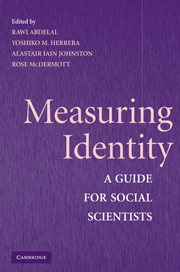Book contents
- Frontmatter
- Contents
- Contributors
- Introduction
- I DEFINITION, CONCEPTUALIZATION, AND MEASUREMENT ALTERNATIVES
- II SURVEY METHODS
- III CONTENT ANALYSIS AND COGNITIVE MAPPING
- 7 Quantitative Content Analysis and the Measurement of Collective Identity
- 8 The Content and Intersection of Identity in Iraq
- 9 A Constructivist Dataset on Ethnicity and Institutions
- IV DISCOURSE ANALYSIS AND ETHNOGRAPHY
- V EXPERIMENTS
- Bibliography
- Index
8 - The Content and Intersection of Identity in Iraq
Published online by Cambridge University Press: 05 June 2012
- Frontmatter
- Contents
- Contributors
- Introduction
- I DEFINITION, CONCEPTUALIZATION, AND MEASUREMENT ALTERNATIVES
- II SURVEY METHODS
- III CONTENT ANALYSIS AND COGNITIVE MAPPING
- 7 Quantitative Content Analysis and the Measurement of Collective Identity
- 8 The Content and Intersection of Identity in Iraq
- 9 A Constructivist Dataset on Ethnicity and Institutions
- IV DISCOURSE ANALYSIS AND ETHNOGRAPHY
- V EXPERIMENTS
- Bibliography
- Index
Summary
INTRODUCTION
We apply our cognitive mapping methodology to the question of identity using the analytical framework of Abdelal et al. (Chapter 1 in this volume) as our starting point. In their contribution, Abdelal et al. begin by establishing their view of a collective identity as a social category that varies along two dimensions, content and contestation. They further suggest that the content of a collective identity can be of four types: constitutive norms, social purposes, relational comparisons with other social categories, and cognitive models.
Constitutive norms refer to the formal and informal rules that define group membership. Social purposes refer to the goals that are shared by members of a group. Relational comparisons refer to the views of other groups or identities that are implied or defined by having a particular identity. Finally, cognitive models refer to the worldviews or understandings of political and material conditions and interests that are shaped by a particular identity (Abdelal et al. Chapter 1 in this volume).
Of these four types of content, cognitive mapping can be applied to the latter three (most directly to cognitive models and relational content, and perhaps least directly to social purposes) on the assumption that all of these types of content are contained in the belief systems of individuals and may be expressed to varying degrees in their speech and writings.
- Type
- Chapter
- Information
- Measuring IdentityA Guide for Social Scientists, pp. 237 - 249Publisher: Cambridge University PressPrint publication year: 2009



